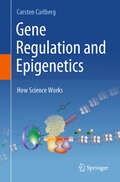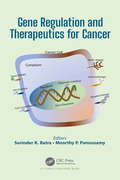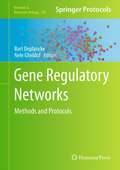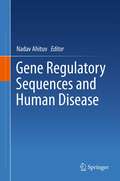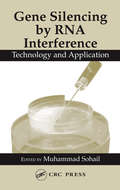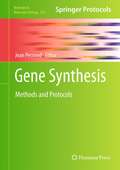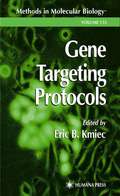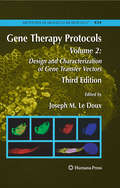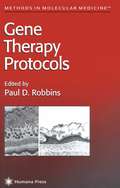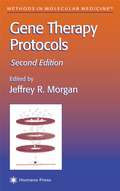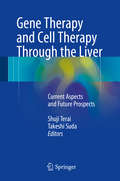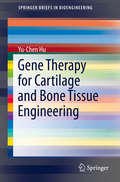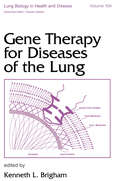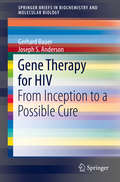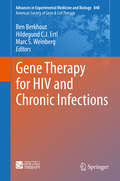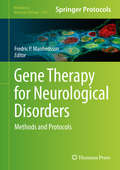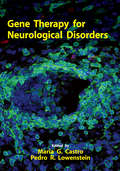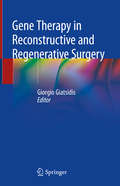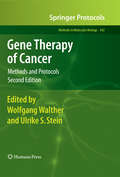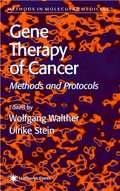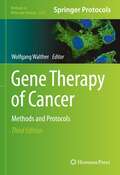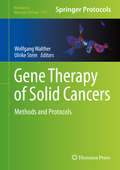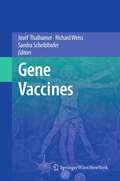- Table View
- List View
Gene Regulation and Epigenetics: How Science Works
by Carsten CarlbergThis book delves into the fascinating realm of eukaryotic gene regulation. The specific expression of genes shapes the phenotype of cells and tissues. The regulation of gene expression, including up- and downregulation, is a fundamental aspect of nearly all physiological processes, both in health and disease. These dynamic processes respond to various daily challenges, such as dietary changes and infections. Therefore, it is crucial for not only biologists and biochemists but also all students in biomedical disciplines to understand gene regulation concepts. This foundational knowledge will benefit them in their specialized fields. A comprehensive understanding of transcription factors and the mechanisms that alter their activity is a fundamental goal of modern life science research. Epigenetics refers to the packaging and accessibility of the genome in each of the trillions of cells in our bodies. The prefix “epi” (meaning “upon,” “above,” or “beyond”) indicates that epigenetic processes do not alter the DNA sequence of our genome, adding a layer of information beyond that encoded in our genome. Genomic DNA is wrapped around complexes of histone proteins, helping it fit into a cell nucleus with a diameter of less than 10 μm. This protein-DNA complex is known as chromatin. The content of this book is linked to the “Molecular Medicine and Genetics” course, which the author has lectured on in various forms since 2002 at the University of Eastern Finland in Kuopio. This book is an updated version of the textbooks “Mechanisms of Gene Regulation” and “Human Epigenomics.” It is divided into 16 chapters. Following two introductory chapters, four chapters explore gene regulation from the perspective of transcription factors, while another four chapters focus on chromatin and non-coding RNA. Three chapters then discuss the impact of epigenetics from a health perspective, and the final three chapters address epigenetics from the perspective of diseases. A glossary in the appendix explains the major specialist terms.
Gene Regulation and Therapeutics for Cancer
by Surinder K. BatraDifferential gene regulation and targeted therapy are the critical aspects of several cancers. This book covers specific gene regulation and targeted therapies in different malignancies. It offers a comprehensive assessment of the transcriptional dysregulation in cancer, and considers some examples of transcriptional regulators as definitive oncogenic drivers in solid tumors, followed by a brief discussion of transcriptional effectors of the programs they drive, and discusses its specific targets. Most targeted therapeutics developed to date have been directed against a limited set of oncogenic drivers, exemplified by those encoding cell surface or cytoplasmic kinases that function in intracellular signaling cascades.
Gene Regulatory Networks
by Nele Gheldof Bart DeplanckeGene regulatory networks play a vital role in organismal development and function by controlling gene expression. With the availability of complete genome sequences, several novel experimental and computational approaches have recently been developed which promise to significantly enhance our ability to comprehensively characterize these regulatory networks by enabling the identification of respectively their genomic or regulatory state components, or the interactions between these two in unprecedented detail. Divided into five convenient sections, Gene Regulatory Networks: Methods and Protocols details how each of these approaches contributes to a more thorough understanding of the composition and function of gene regulatory networks, while providing a comprehensive protocol on how to implement them in the laboratory. Written in the highly successful Methods in Molecular BiologyTM series format, chapters contain introductions to their respective topics, lists of the necessary materials and reagents, step-by-step, readily reproducible laboratory protocols, and notes on troubleshooting and avoiding known pitfalls. Authoritative and accessible, Gene Regulatory Networks: Methods and Protocols aims to provide novices and experienced researchers alike with a comprehensive and timely toolkit to study gene regulatory networks from the point of data generation to processing, visualization, and modeling.
Gene Regulatory Sequences and Human Disease
by Nadav AhituvIn Gene Regulatory Sequences and Human Disease, the Editor will introduce the different technological advances that led to this breakthrough. In addition, several examples will be provided of nucleotide variants in noncoding sequences that have been shown to be associated with various human diseases.
Gene Silencing by RNA Interference: Technology and Application
by Muhammad SohailMaximizing the potential of RNA interference in functional genomics - as well as in the development of therapeutics - continues to be at the forefront of biomedical research. Unlike journal articles, Gene Silencing by RNA Interference: Technology and Application combines essential background to the RNAi field with practical techniques designed by r
Gene Synthesis
by Jean PeccoudThe de novo fabrication of custom DNA molecules is a transformative technology that significantly affects the biotechnology industry. Basic genetic engineering techniques for manipulating DNA in vitro opened an incredible field of opportunity in the life sciences. In, Gene Synthesis: Methods and Protocols expert researchers in the field detail many of the methods which are now commonly used to fabricate DNA . These include methods and techniques for the assembly of oligonucleotide, cloning of synthons into larger fragments, protocols and software applications, and educational and biosecurity impacts of gene synthesis. Written in the highly successful Methods in Molecular BiologyTM series format, the chapters include the kind of detailed description and implementation advice that is crucial for getting optimal results in the laboratory. Thorough and intuitive, Gene Synthese: Methods and Protocols aids scientists in understanding all the different stages of a complex gene synthesis process, while refining their understanding of gene synthesis and determine what part of the process they can or should do in their laboratory and what parts should be contracted to a specialized service provider.
Gene Targeting Protocols
by Eric B. KmiecA panel of innovative investigators presents, in readily reproducible detail, the latest techniques for gene replacement, gene knockout, and gene repair in both plants and animals. These expert researchers review the best gene transfer vehicles (liposomes, PEI, and EPD), discuss the parameters that affect vector uptake, and detail successful methods for gene targeting (Cre-ox, and adeno and adeno-associated viruses). The methods include two fundamentally different approaches to gene targeting-one uses a fusion protein to deliver a vector to a virus for possible therapeutic effect, and the other entails an episomal-based Epstein-Barr vector that can modulate the chromatin assembly process, and thus overcome a serious barrier to therapeutic gene targeting. The book also has several techniques for using oligonucleotides in gene targeting, a methodology that may well revolutionize the entire field. Gene Targeting Protocols offers today's researchers robust and proven gene-targeting techniques that are essential to understanding biological processes at the genetic level.
Gene Therapy , Third Edition, Volume 2: Design and Characterization of Gene Transfer Vectors
by Joseph LedouxIn Gene Therapy Protocols, Volumes 1 & 2, internationally recognized investigators describe cutting-edge laboratory techniques for the study of Production and In Vivo Applications of Gene Transfer Vectors (Volume 1) and Design and Characterization of Gene Transfer Vectors (Volume 2). The field of gene therapy has undergone remarkable advances, promising to impact human healthcare significantly in the twenty-first century. Today’s technologies can deliver genetic material safely and effectively to cells to slow or halt the progression of disease, and to help repair or regenerate damaged or lost tissues. In this second volume of Gene Therapy Protocols: Design and Characterization of Gene Transfer Vectors, readers will find a comprehensive resource of current and emerging methods for the processing and characterization of viral and non-viral gene transfer vectors, as well as promising approaches to design vectors for efficient, targeted and regulated gene delivery and expression. This second volume of the new and completely revised third edition of Gene Therapy Protocols will prove a necessary tool for graduate students and postdoctoral fellows and invaluable to basic and clinical researchers in both industry and academia.
Gene Therapy Protocols (Methods in Molecular Medicine #7)
by Paul D. RobbinsIn Gene Therapy Protocols, leading researchers describe in detail all the essential molecular methods for developing gene transfer systems, along with the methods for introducing genes into specific tissue types either in vivo or ex vivo. These easily reproducible methods range from those for specific viral and nonviral delivery systems, to those concerned with gene delivery to particular tissues. Methods for applying specific therapeutic systems, such as ribozymes and tumor suppressor genes for the treatment of AIDS and cancer, are also included in this authoritative collection.<P><P> Gene Therapy Protocols is the first major collection of the methods needed for successful gene delivery and subsequent in vivo gene expression, techniques at the center of the many and significant recent advances in the treatment of both genetic and acquired diseases. It will surely become today's indispensable standard reference source for all scientists working to realize the promises of gene therapy.
Gene Therapy Protocols, 2nd Edition
by Jeffrey R. MorganSignificant advances in gene transfer technology and the completion of sequencing the human genome offer much renewed hope that gene therapy will provide novel approaches to the treatment of inherited and acquired diseases. In this fully updated and revised 2nd edition of the warmly received Gene Therapy Protocols, leading experts from academic and industrial laboratories around the world detail their most effective viral and nonviral methods of gene transfer, as well as discuss their applications in different organ systems. The methods range from those in which new molecular conjugates show great promise for targeting targeting gene transfer and regulating transgene expression, to those used in such exciting applications as the delivery of therapeutic proteins, vaccination, and tissue engineering. In addition, there are completely revised methods based on retroviruses and adenoviruses, as well as new and promising methods based on lentiviruses and adeno-associated viruses. The quantitative aspects of gene therapy are strongly emphasized, and the book reflects the many significant recent improvements in gene transfer efficiency, gene regulation, and vector production.<P><P> Up-to-date and highly practical, Gene Therapy Protocols, 2nd Edition, offers a rich compilation of the revolutionary advances that have recently occurred in gene transfer technology, with each article providing proven step-by-step laboratory procedures that enable successful therapeutic application.
Gene Therapy and Cell Therapy Through the Liver
by Shuji Terai Takeshi SudaThis book reports the recent progress in gene and cell therapy through the liver and aims to facilitate a comprehensive understanding of the current aspects and future prospects from basic research to clinical therapies. Edited by pioneering researchers, this volume presents extensive information to principal investigators, researchers, postdocs and clinicians for examining the wide varieties of pathological conditions both inside and outside the liver. Providing not only the basic and clinical aspects of therapy, this volume is special in that it focuses on the administrative and regulatory difficulties of actual clinical application and legal regulations in different parts of the globe. By indicating the advantages and limitations of the most promising gene and cell therapies targeting the liver, this book will inspire readers to develop a feasible treatment in the next generation.
Gene Therapy for Cartilage and Bone Tissue Engineering
by Yu-Chen Hu"Gene Therapy for Cartilage and Bone Tissue Engineering" outlines the tissue engineering and possible applications of gene therapy in the field of biomedical engineering as well as basic principles of gene therapy, vectors and gene delivery, specifically for cartilage and bone engineering. It is intended for tissue engineers, cell therapists, regenerative medicine scientists and engineers, gene therapist and virologists. Dr. Yu-Chen Hu is a Distinguished Professor at the Department of Chemical Engineering, National Tsing Hua University and has received the Outstanding Research Award (National Science Council), Asia Research Award (Society of Chemical Engineers, Japan) and Professor Tsai-Teh Lai Award (Taiwan Institute of Chemical Engineers). He is also a fellow of the American Institute for Medical and Biological Engineering (AIMBE) and a member of the Tissue Engineering International & Regenerative Medicine Society (TERMIS)-Asia Pacific Council.
Gene Therapy for Diseases of the Lung (Lung Biology In Health And Disease Ser.)
by Kenneth L. BrighamThis up-to-the-minute and comprehensive resource lucidly covers gene therapy for lung diseases from existing technologies delivering foreign DNA to the lungs via the airways or circulation to promising new approaches for the further development of safe and efficient gene delivery systems.
Gene Therapy for HIV
by Gerhard Bauer Joseph S. AndersonThis Brief describes the concept and realization of gene therapy for HIV from the unique historic perspective and insight of two pioneers of the clinical applications of stem cell gene therapy for HIV. Gerhard Bauer applied ribozyme-anti-HIV and other vectors to manufacture clinical grade, HIV-resistant hematopoietic stem cells for the first patients that received stem cell gene therapy for HIV, including the first child in the world and the first fully marrow-ablated HIV infected patient. Joseph Anderson developed the most recent and most potent combination anti-HIV lentiviral vectors and pluripotent stem cell applications for HIV gene therapy and tested these in the appropriate in vitro and vivo models, paving the way for novel HIV gene therapy approaches to possibly cure patients. In Gene Therapy for HIV, Bauer and Anderson discuss the unique aspects of this therapy, including its limitations and proper safety precautions and outline a path for a possible functional cure for HIV using stem cell gene therapy based on a cure already achieved with a bone marrow stem cell transplantation performed in Germany using donor stem cells with a naturally arising CCR5 mutation. In addition, the Brief provides a thorough and methodical explanation of the basics of gene therapy, gene therapy vector development, in vitro and in vivo models for HIV gene therapy and clinical applications of HIV gene therapy, including Good Manufacturing Practices.
Gene Therapy for HIV and Chronic Infections
by Ben Berkhout Hildegund C.J. Ertl Marc S. WeinbergThis book centers on gene therapy and gene transfer approaches to prevent or treat chronic virus infections. The main focus is on the Big Three: human immunodeficiency virus (HIV-1), hepatitis B virus (HBV) and hepatitis C virus (HCV). Ample anti-HIV drugs are currently available in the clinic and the development of an effective combination therapy has dramatically improved the lifespan and quality of life of infected individuals. A similar trend can already be recognized for HBV and HCV: the development of multiple (directly acting) antiviral drugs and plans to control or even cure the infection. However, approaches that help prevent infection, or which provide long-lasting treatment (such as a cure) remain important goals. Immunization through gene transfer vehicles encoding immunogenic viral proteins shows promise in preventing infections with complex, highly variable, viruses such as HIV-1 or HCV. Gene therapy applications for virus infections have been discussed since the early 1990's. Whereas a true cure seems difficult to achieve for HIV-1 due to its intrinsic property to deposit its genome into that of the host, such attempts may be within reach for HCV where spontaneous viral clearance occurs in a small percentage of the infected individuals. The prospect of original gene therapy approaches may provide alternative ways to reach the same endpoint by, for example, silencing of CCR5 expression post-transcriptionally. Many alternative antiviral strategies have been developed based on a variety of novel molecular methods: e. g. ribozymes. Some studies have progressed towards pre-clinical animal models and a few antiviral gene therapies have progressed towards clinical trials. This book provides an overview of this rapidly progressing field, while focusing on the interface of gene therapy and immunology/vaccinology.
Gene Therapy for Neurological Disorders
by Fredric P. ManfredssonThis volume provides a clear and detailed roadmap of how to design and execute a gene therapy experiment in order to obtain consistent results. Chapters in this book disseminate bits of unknown information that are important to consider during the course of experimentation and will answer questions such as: What delivery vehicle do you use?; How will you ensure that your vector retains stability?; What expression system best fits your needs?; What route will you choose to deliver your gene therapy agent?; How will you model the neurodegenerative disorder that you aim to investigate and what are the proven methods to treat these disorders in preclinical models? Written in the highly successful Methods in Molecular Biology series format, chapters include introductions to their respective topics, lists of the necessary materials and reagents, step-by-step, readily reproducible laboratory protocols and tips on troubleshooting and avoiding known pitfalls. Authoritative and thorough, Gene Therapy for Neurological Disorders: Methods and Protocols, is a compilation of protocols and instructive chapters intended to give researchers, clinicians, and students of all levels, a foundation upon which future gene therapy experiments can be designed.
Gene Therapy for Neurological Disorders
by Pedro R. Lowenstein Maria G. CastroCoedited by internationally recognized leaders in gene therapy research, this guide supplies the most recent advances, studies, and expert opinion on gene therapy for neurological disorders. Spanning conditions such as Parkinsons's and Alzheimer's disease, multiple sclerosis, brain tumors, stroke, epilepsy, and brain and spinal cord trauma, this reference presents the basic science and applications of recombinant gene products, immune and stem cell-mediated therapeutic strategies, and brain tumor gene therapy.
Gene Therapy in Reconstructive and Regenerative Surgery
by Giorgio GiatsidisThis book offers an updated overview of the most recent research advances in the field, a comparison of established techniques and methods, a discussion on current experimental and translational challenges, and a commentary on potential opportunities and future directions.Dedicated chapters address and review the preclinical and clinical state-of-the-art of gene therapies for the reconstructive and regenerative surgery of skin and wounds, pathological scars, cartilage, tendons, skeletal muscles, and bio-engineered flaps. A brief guide to developing gene therapy clinical trials in the context of reconstructive and regenerative surgery is also provided.Biomedical and technological innovations are transforming our capacity to use gene therapies to safely and effectively repair, reconstruct, and regenerate tissues that are deficient or have been damaged by trauma and diseases. The targeted and controlled modulation of gene expression in tissues represents a game-changing, next-generation therapeutic tool for the modern reconstructive surgeon, expanding the horizon of regenerative surgery and tissue engineering. Through gene therapies, surgeons can direct (stem) cell differentiation and cell function, modulate the release of growth/transcriptional factors, affect the biological properties of regenerative scaffolds, control tissue inflammation, or induce immune-suppression in composite tissue allotransplants and xenotransplants.Written by renowned reconstructive surgeons and leading experts in each of these fields - from top academic institutions around the globe, the book provides an initial practical guide for veteran and newcomer surgeons alike, as well as for researchers interested in exploring the latest gene-based therapeutic strategies for reconstructive and regenerative surgery.
Gene Therapy of Cancer
by Wolfgang Walther Ulrike S. SteinDespite various difficulties, the field of gene therapy, particularly with regard to cancer, has accumulated a tremendous amount of vital pre-clinical and clinical data. "Gene Therapy of Cancer: Methods and Protocols, Second Edition" fully updates the first edition with expert coverage of established and novel protocols involving both experimental and clinical approaches to cancer gene therapy. This state-of-the-art volume contains overviews of new concepts and strategies with chapters on regulatory and ethical issues, developments, problems and possible limitations of design and production of gene therapeutics as well as translational issues. Written in the highly successful Methods in Molecular BiologyTM series format, chapters include introductions to their respective topics, lists of the necessary materials and reagents, step-by-step, readily reproducible protocols, and notes on troubleshooting and avoiding known pitfalls. Cutting edge and authoritative, "Gene Therapy of Cancer: Methods and Protocols, Second Edition" is an ideal guide for all those who wish to explore the fast-paced and critical study of nonviral, viral, experimental and clinical cancer gene therapy.
Gene Therapy of Cancer
by Wolfgang Walther Ulrike SteinWolfgang Walther and Ulrike Stein survey the rapidly evolving field cancer gene therapy and provide a broad array of leading-edge protocols for the delivery of therapeutic genes into tumors. Described in step-by-step fashion and enriched with each author's own practical tips, these readily reproducible methods are currently being widely applied in cancer gene therapy investigations, including immunotherapy and tumor vaccination, suicide gene therapy, antioncogene therapy, and antisense and ribozyme gene therapy. Representative strategies are provided for gene targeting and for viral or nonviral gene delivery in cancer therapy, as well as a significant number of clinical protocols for the development of novel cancer gene therapies. Gene Therapy of Cancer offers basic and clinical researchers a broad ranging overview and collection of the most recent advances in gene transfer techniques. Written by leading international authorities, its readily reproducible, cutting-edge methods constitute today's most valuable tools for the study of cancer gene therapy in both the laboratory and clinical trials.
Gene Therapy of Cancer: Methods and Protocols (Methods in Molecular Biology #2521)
by Wolfgang WaltherThis third edition provides new and updated chapters on gene therapeutic strategies of cancer. Chapters guide readers through suicide and oncolytic gene therapy, gene replacement and gene suppression therapy, vector development and refinement, immunogene therapy, TCR and CAR engineering, tumor vaccination using DNA or RNA vaccines, and antitumoral immune stimulation at different levels. Written in the format of the highly successful Methods in Molecular Biology series, each chapter includes an introduction to the topic, lists necessary materials and reagents, includes tips on troubleshooting and known pitfalls, and step-by-step, readily reproducible protocols. Authoritative and cutting-edge, Gene Therapy of Cancer: Methods and Protocols, Third Edition aims to be a useful and practical guide to new researchers and experts looking to expand their knowledge.
Gene Therapy of Solid Cancers
by Wolfgang Walther Ulrike SteinThis volume provides insight into recent developments on experimental and clinical strategies for cancer gene therapy. Gene Therapy of Solid Cancers: Methods and Protocols guides readers through protocols on gene therapeutic strategies in combination with helpful technical notes. Written in the highly successful Methods in Molecular Biology series format, chapters include introductions to their respective topics, lists of the necessary materials and reagents, step-by-step, readily reproducible laboratory protocols, and key tips on troubleshooting and avoiding known pitfalls. Concise and easy-to-use, Gene Therapy of Solid Cancers: Methods and Protocols aims to ensure successful results in the further study of this vital field.
Gene Tierney: Star of Hollywood's Home Front (Contemporary Approaches to Film and Media Series)
by Will ScheibelGene Tierney may be one of the most recognizable faces of studio-era Hollywood: she starred in numerous classics, including Leave Her to Heaven, The Ghost and Mrs. Muir, and Laura, with the latter featuring her most iconic role. While Tierney was considered one of the most beautiful women in Hollywood, she personified "ordinariness" both on- and off-screen. Tierney portrayed roles such as a pinup type, a wartime worker, a wife, a mother, and, finally, a psychiatric patient—the last of which may have hit close to home for her, as she would soon leave Hollywood to pursue treatment for mental illness and later attempted suicide in the 1950s. After her release from psychiatric clinics, Tierney sought a comeback as one of the first stars whose treatment for mental illness became public knowledge. In this book, Will Scheibel not only examines her promotion, publicity, and reception as a star but also offers an alternative history of the United States wartime efforts demonstrated through the arc of Tierney’s career as a star working on the home front. Scheibel’s analysis aims to showcase that Tierney was more than just "the most beautiful woman in movie history," as stated by the head of production at Twentieth Century Fox in the 1940s and 1950s. He does this through an examination of her making, unmaking, and remaking at Twentieth Century Fox, rediscovering what she means as a movie legend both in past and up to the present. Film studies scholars, film students, and those interested in Hollywood history and the legacy of Gene Tierney will be delighted by this read.
Gene Transfer and Expression Protocols
by Edward J. MurrayMurray's new handbook on Gene Transfer and Expression Protocols sets forth both current and new methodologies in a clear, concise, easy-to-follow manner, following the successful formula of the classic volumes in Humana's Methods in Molecular Biology series. Each chapter is devoted to a thorough exposition of a single technique. An Introduction explains the significance of the protocol and provides background information. A Materials section lists all the requirements for the technique discussed. A Methods section details the procedure in a step-by-step protocol. A Notes section alerts the reader to pitfalls that may be encountered, as well as alternatives that may be used for successful completion of the experiment. Each technique is designed to guarantee optimum results. This volume is an outstanding new benchtop manual that provides protocols for introducing an isolated gene into a cell line, using various transfection techniques. Topics and techniques include: viral vectors * reporter genes * analysis of steady-state level of transcription * assay for newly initiated transcriptional complexes * immunocytological techniques * assay of structure and replication state of transfected genes * overall strategy for defining regulatory sequences Providing the latest techniques in a fast-paced area, Gene Transfer and Expression Protocols is an absolutely essential handbook for everyone involved in cytogenetics, cell genetics, molecular biology, and related fields.
Gene Vaccines
by Richard Weiss Sandra Scheiblhofer Josef ThalhamerThe induction of antigen-specific immune responses after in vivo transfection with expression plasmids has triggered a revolution of vaccine research. After a first hype, evoked by the fascinating options of this method, clinical studies did not reach the ambitious aims and a phase of disillusion ensued. It became obvious that Gene vaccines displayed a weaker immunogenicity in humans than had been observed in the mouse models. Meanwhile these hurdles have been overcome and gene vaccines undergo a renaissance. The present book gives an update of the "world of naked gene vaccines", namely DNA and RNA vaccines. Its content ranges from general mechanisms, inherent immunostimulatory properties and the vast potential to modulate immune responses, to recent successful clinical studies and approved veterinary gene vaccines. Beyond the state-of-the-art of genetic immunization, the reader will be stimulated with a chapter addressing "burning questions".
